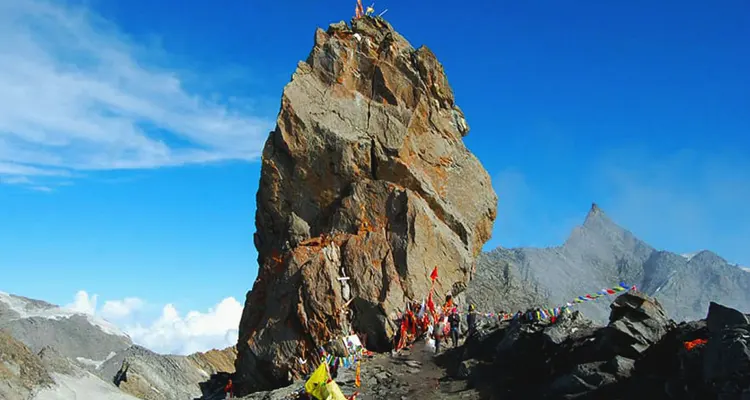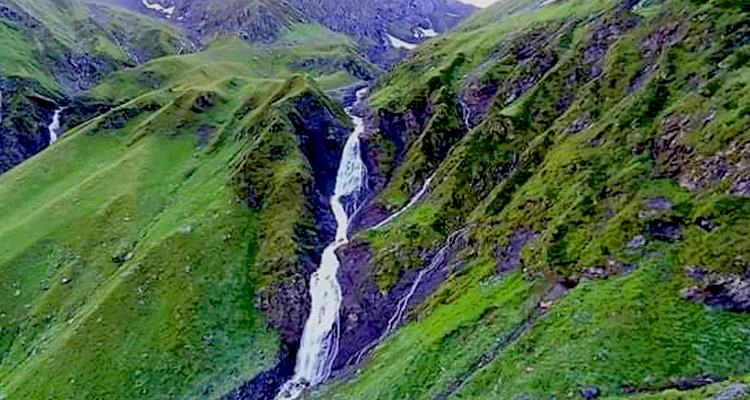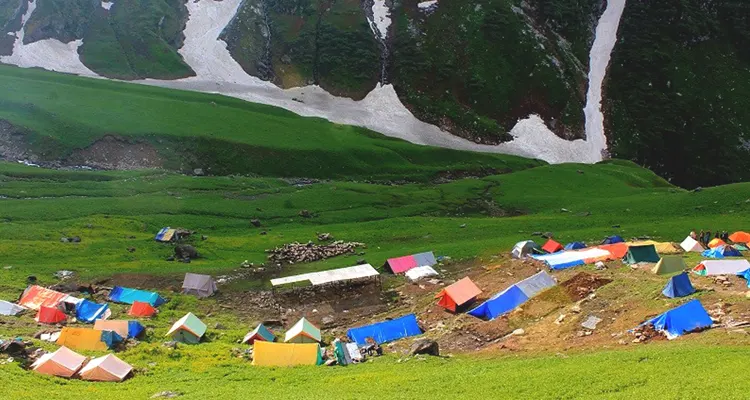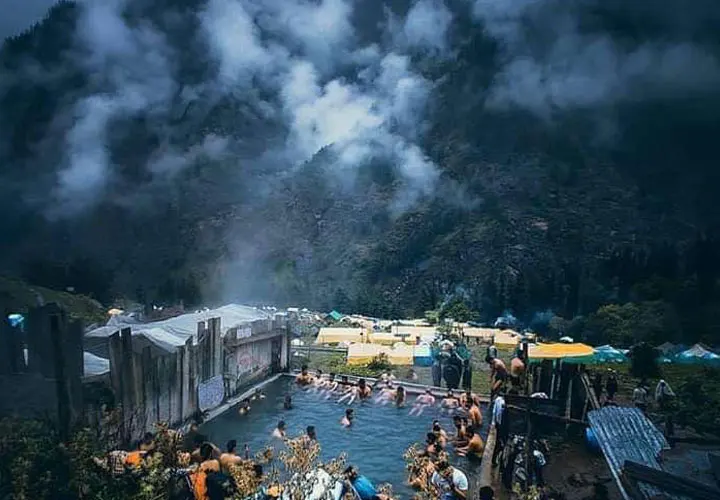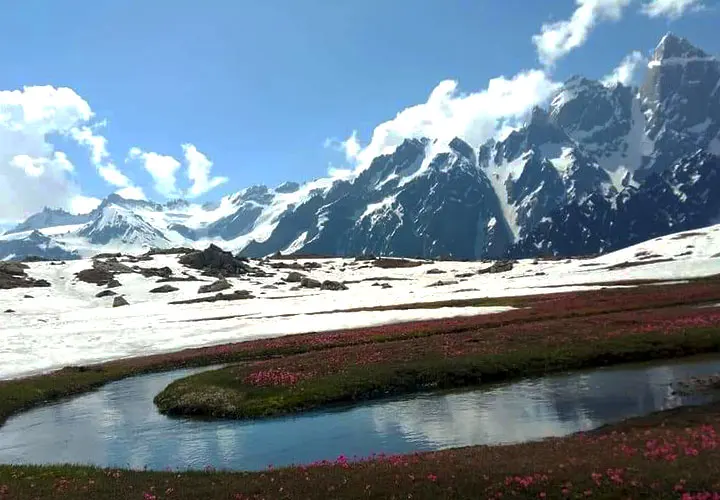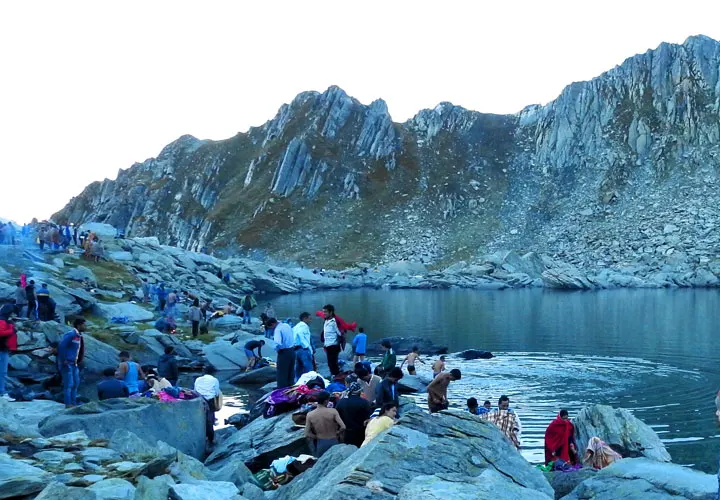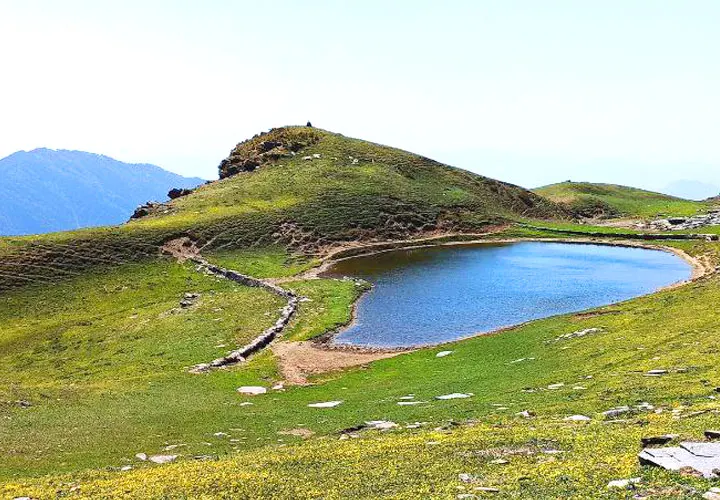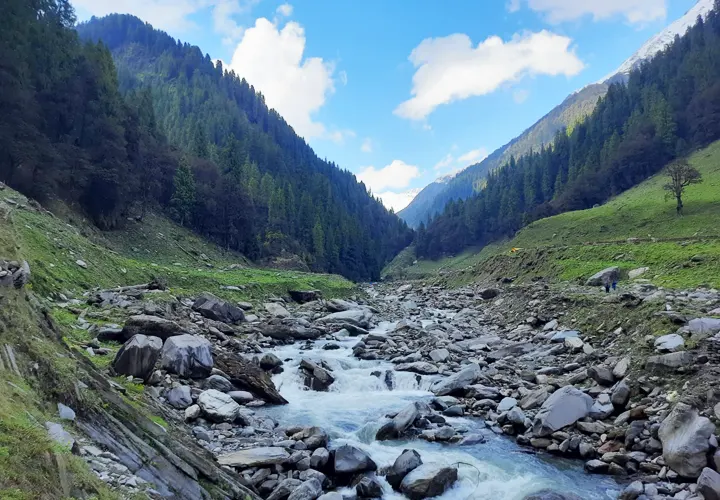Shrikhand Mahadev Trek 68 Km (Height 5227 M)- May-Sep
Shrikhand Mahadev Trek 68 Km (Height 5227 M) - May-Sep
SHRIKHAND MAHADEV YATRA TREK
Embark on a journey to Himachal Pradesh and experience the Shrikhand Mahadev Yatra at competitive and reasonable prices. We offer a range of accommodations and camping options. Here, you will find a diverse selection of treks throughout Himachal Pradesh, with the option to choose from our curated treks or to create a customized trek tailored to your preferences.
Key locations to explore include in Shrikhand Mahadev Trek Jaon, Singhad, Brati Nala, Thachdu, Kali Ghati, Bheem Talai, Bheem Dwari, Parvati Bagh, Nainsarovar, Bheem Shila, and Shrikhand Mahadev.
The Shrikhand Mahadev trek is a revered pilgrimage route that ascends to the Shrikhand Mahadev peak, which stands at an elevation of (Shrikhand Mahadev Height) 5,227 meters (17,150 feet) and is named in honor of Lord Shiva. This trek is particularly renowned for its stunning vistas of the Himalayan ranges, including the Parvati Valley of Kullu, the Jorkandan and Rangrik ranges of Kinnaur, as well as the Hansbeshan and other peaks situated to the southeast of the Satluj River. The journey can commence from either the Nirmand side or the Arsu side.
The most frequented path is from the Nirmand Jaon village. To access the base camp, one must travel from Shimla towards Rampur, cross the Satluj River, and proceed into the Nirmand region of Kullu district, ultimately reaching Jaon Village.
This destination holds significant appeal for both devotees and climbers alike, making the Shrikhand Mahadev Trek Package a popular choice. A few glaciers must be traversed before arriving at the magnificent Shrikhand peak, where pilgrims engage in puja rituals. The panoramic view from the summit is truly breathtaking, providing a sensation of being on top of the world. The surrounding snow-capped mountains enhance the majestic scenery. However, due to the fierce and frigid winds at the peak, prolonged stays are not advisable.
Kartikey Parvat (Lord Kartikey Mountain):
Kartikey Mountain is revered as the abode of Lord Kartikey, the elder son of Lord Shiva and the commander of the divine army. The trek to this mountain peak commences from Shrikhand Top. On a clear day, visitors can enjoy a panoramic view of the mountain from the summit. Upon reaching the top of Shrikhand Mahadev, trekkers often perceive the journey to Kartikey Mountain as relatively straightforward, believing that it can be traversed with ease. However, the reality is that no one has ever successfully reached this mountain peak.
According to local lore, no individual has managed to ascend Kartikey Parvat to date. The locals hold the belief that should someone reach this mountain, Lord Kartikey would appear before them and grant one wish, as decreed by Lord Shiva, his father. Numerous tales of attempts to conquer this mountain exist, yet none have achieved success. One such story recounts the experience of three local friends who resolved to climb the mountain. They packed sufficient provisions to sustain them for over three days, but as night fell on the first day, they began to feel hunger. As the night progressed, their hunger intensified, leading them to consume all their food in one sitting. The following day, they found themselves unable to continue the trek and ultimately decided to return home.
Shrikhand Mahadev trek route
Baga Sarahan to Jaon Singhad
Following a period of exploration in Jaon, the ascent to Singhad, which rises to an altitude of 6,873 feet, began. The path from Jaon to Singhad extends for 3 kilometers along the right bank of the Kurpan River. Trekkers will discover numerous apple orchards, gentle streams, and a village adorned with picturesque old houses, predominantly two stories in height, along the way. The journey to Singhad generally requires about one hour and is well-maintained alongside the Kurpan. Singhad acts as a sanctuary where visitors can rest and revitalize themselves. It is a revered location where individuals often engage in rituals to celebrate the successful completion of their trek. The region is dotted with several temples and is surrounded by verdant forests, particularly distinguished by a significant presence of Deodar trees.
Singhad to Thachru
The next phase of the expedition leads to Barathi Nalah, located at an elevation of 7,283 feet, where two minor streams converge to create the Kurpan. The journey to Barathi Nalah is remarkably scenic, spanning a distance of 3 kilometers and requiring approximately 1.5 hours to complete. During this portion of the trek, adventurers may encounter the need to cross the Kurpan via a wooden bridge constructed from Deodar wood, which adds an exhilarating touch and fosters a connection with the natural surroundings. Barathi Nalah serves as an excellent resting point before the ascent to Thachru, which entails a steep climb of 6 kilometers along Danda Dhaar, estimated to take between 6 to 8 hours. This ascent necessitates significant endurance, and it is recommended to take breaks throughout the journey. The trail winds through dark Deodar forests, where the thick canopy limits visibility, yet the sounds of rivers, streams, and waterfalls are distinctly audible.
Given the absence of water sources on the way to Thachru, it is essential to carry a sufficient supply of water for the trek. As trekkers ascend, they will observe a change in vegetation, and from various viewpoints, they can catch glimpses of the Kullu Himalayas. The trail is adorned with ancient Deodar trees, some of which are centuries old. The journey to Thachru also presents opportunities to spot beautiful birds, and there are cliffs that offer breathtaking views of the lush forest and the stream below.
Thachru, positioned at an altitude of 11,318 feet, signifies the end of the tree line, transitioning into a landscape dominated by herbs and shrubs that define the next segment of the trek. The evenings in this area are particularly captivating, providing sweeping views of the Sarahan and Kotgarh regions to the south, the Shrikhand peak to the east, and the Kullu Himalaya to the west. Thachru is an ideal site for an overnight stay, following a demanding vertical ascent of 6 to 8 kilometers.
Thachru – Kaali Ghat – Kunsha-Bheem Dwar
The journey from this location to Parvati Baag is relatively easy and does not require significant exertion. The trek from Taacharu to Kaali Ghat involves a direct ascent of 3 kilometers, which generally takes around 1.5 hours to complete. Trekkers may come across some rare Himalayan flora along this path. The route to Kaali Ghat heads straight north, featuring a steep drop on one side. After approximately one hour of trekking, one reaches an open area with large rocks, offering a close view of the surrounding mountains. From this point, it takes an additional 15 minutes to arrive at Kaali Ghat, situated at an elevation of 12,778 feet. This marks the end of the vertical ascent that began at Barathi Nala.
At Kaali Ghat, one can appreciate a panoramic view of the Himalayas. This site also houses a small temple dedicated to Maa Kali. After a moment of reverence, the next segment of the journey commences. The trek from Kaali Ghat to Bhim Talai covers a distance of just 1.5 kilometers and can be accomplished in about 30 minutes due to its gentle slope. Bhim Talai is rich in legend, thought to be a bathing place for Bhim, one of the Pandava brothers. This area is surrounded by towering peaks, verdant bugiyal, and flowing waterfalls, and it is common to see shepherds nearby. Bhim Talai is located at an altitude of 11,279 feet.
The journey from Bhim Talai to Kunsha, situated 3 kilometers further along, features a well-maintained path that can be completed in approximately 1.5 hours. After traversing the vast Big Bugyals (grasslands), trekkers will come across a glacier that measures about 500 meters in length and 80 meters in width. Beyond this glacier, the route to Kunsha requires navigating rocky terrain. At an altitude of 12,746 feet, Kunsha is surrounded by stunning waterfalls, providing awe-inspiring views. The natural splendor of this area is extraordinary, allowing visitors to linger for hours, captivated by the waterfalls, clouds, and diverse plant life. It is an excellent location for relaxation and rejuvenation in a natural setting.
The trek from Kunsha to Bheem Dwar follows a relatively flat path with slight inclines and declines, covering a distance of 3 kilometers and taking roughly 2 hours to finish. This trail is embellished with rare Himalayan flowers and various shrubs, reminiscent of the Valley of Flowers in Uttarakhand. Trekkers are likely to encounter distinctive floral species in this expansive region, which offers expansive views of deep valleys, gorges, cascading waterfalls, and small streams along the route. The Kunsha valley showcases a beautiful landscape of clouds, mountains, and patches of snow, accompanied by the calming sounds of swiftly flowing streams, creating a truly enchanting experience.
After dedicating two hours to exploring this serene meadow, one reaches Bheem Dwar, located at an elevation of 12,175 feet. It is said that the Pandavas sought shelter in this region during their period of exile, and it is now known as Bheem Dwar. This vast Bugyal is encircled by magnificent waterfalls and a multitude of glaciers. As one continues towards Parvati Baag, the trek involves traversing the largest waterfall encountered along this route.
Bheem Dwar To Parvati Baag to Shrikhand Mahadev and back to Bheem Dwar
The Shrikhand Mahadev Yatra, held annually in July, identifies Bheem Dwar as a crucial base for pilgrims. This site is also frequented by shepherds who graze their sheep and goats in the area. Pilgrims may take advantage of the natural caves at Bheem Dwar, which many opt to use for rest. The breathtaking beauty of the surroundings captivates visitors, allowing them to spend considerable time appreciating the natural landscape.
Parvati Baag, located at an altitude of 13,622 feet, is positioned merely 3 kilometers from Bheem Dwar, with a trek that generally requires about two hours to complete. The initial portion of the trek is relatively easy, leading to a prominent waterfall. However, after the waterfall, a challenging ascent of 2.5 kilometers must be navigated to reach Parvati Baag, which is an ideal location for an overnight stay. Local folklore suggests that this area was often visited by Mata Parvati, which is reflected in its name. Parvati Baag is celebrated for its wide variety of rare flowers native to the higher Himalayas, including the rare Brahma Kamal, which flourishes abundantly in this region. This site is located just below the revered Shrikhand Mountain, and at night, the view is so stunning that it creates the impression of being able to touch the sky.
To return to Nain Sarovar, one must undertake a demanding and steep trek from this juncture onward. The initial phase of this journey from Nain Sarovar requires crossing a 200-meter glacier, which may take around 45 minutes to traverse a distance of just 0.5 kilometers. This segment necessitates substantial physical stamina. Upon completion of this stretch, trekkers reach a cliff summit at an elevation of 14,967 feet, where the breathtaking view of Nain Sarovar Lake becomes clearly visible. In the direction of Shrikhand, one can observe large boulders and glaciers. If one arrives early in the morning, the magnificent Kinnaur Mountains can also be admired from this viewpoint.
The next part of the trek is marked by an abundance of moraines and sparse patches of snow. To reach Shrikhand, one must ascend seven minor peaks. As the sun rises, the feeling of being above the clouds becomes increasingly evident. The route to Bheem Bailee involves navigating numerous small stone tunnels, glaciers, and moraines. Bheem Bailee, located at an altitude of 15,921 feet, is a significant site dedicated to Bheem.
Here, various markings can be seen on the stones, with legends indicating that Bheem once attempted to build a staircase to Heaven, a project left incomplete due to time limitations. The arrangement of stones, stacked upon one another, resembles a stairway. From Bheem Bailee, the sacred Shrikhand Shila is visible, and it takes approximately thirty minutes to reach Shrikhand, requiring the crossing of a substantial glacier.
This site provides an unobstructed panorama of the Himalayas on three sides, while the fourth side reveals a stunning view of Rampur Sarahan and the hills surrounding Shimla. Situated at an elevation of 17,150 feet, Shrikhand is a location where the essence of nature is deeply experienced. It is said that everything in this area is connected to the divine presence of Lord Shiva. From this perspective, one can view the Kinnaur Himalaya on one side and the mountains of Kullu and Shimla on the opposite side.
Return to Bheem Dwar
The route for the remaining days until your return to Jaon will follow the same path you initially took to reach Bheem Talai.
How to reach Shrikhand Mahadev
Trek Access Points: The trek can commence from Nirmand in the Kullu district, Fancha in the Shimla district, or from Banjar. The most arduous route is from the Fancha side, while the most favored and secure option is through Nirmand, Bagipul, Jaun, Taacharu, and Nainser.
Shrikhand Mahadev trek cost: Rs 17,499 Per Person.
Inclusion and Exclusion
Inclusions:
• Comfortable and tidy accommodation on a shared basis (first and last nights in a homestay in Baga Sarahan (Jaon village) and camping during the trek).
• Meals provided from the first days dinner to the final days breakfast (comprising 6 lunches, 6 breakfasts, and 6 dinners, along with evening tea and snacks).
• Transportation from Chandigarh to Baga Sarahan (Jaon village) and back to Chandigarh via Tempo Traveller or a similar vehicle.
• Services of a certified and experienced trek leader, local guide, and support staff (including cook, helper, porter, and mules).
• All necessary camping and forest permits.
• A group captain will accompany the entire tour.
• First aid medical kit and portable oxygen cylinder.
• Camping equipment, including tents, sleeping bags, mats, kitchen tents, and utensils.
Exclusions:
Any airfare and transportation costs to reach the designated meeting point.
Any services not specified in the inclusions. Insurance, emergency evacuation fees, rescue charges, hospitalization, and any meals or snacks during land transfers.
Any off-loading or porterage of personal luggage or personal porter services.
Shrikhand Mahadev trek best time to visit in May to September month of the year( with permission from Himachal tourism & forest department ).
Shrikhand Mahadev trek opening Date 2025.
Shrikhand Mahadev trek route :
Jaon-Singhad-Brati-Nala-Thachdu-Kali Ghati-Bheem Talai-Bheem Dwari-Parvati Bagh-Nainsarovar-Bheem Shila-Shrikhand Mahadev trek Top.
Places between treks :
Jaon is the small village in Nirmand tehsil of Kullu District, Singhad, Brati-Nala or Brati Khumba, Thachdu,
Kali Tibba or Kaali Top, Bheem Talai, Bheem Dwari, Parvati Bagh, Nainsarovar (Pond of Tears of Goddess), Bheem Shilaye, Shrikhand Mahadev Top.
Shrikhand Mahadev trek height : 5227 meters (equivalent to 17,150 feet approx.)
Shrikhand Mahadev trek distance : The trek covers approximately 33-34 kilometers one way.
Trail Difficulty: This trek presents demanding gradients characterized by steep inclines, navigating through rugged glacier regions and rocky moraine trails. It is recommended that those without sufficient experience in high-altitude trekking avoid undertaking this route.
Nearest Rail Station: The closest railway station to Jaon village is situated in Shimla, roughly 170 kilometers distant. Access to Shimla is provided by a narrow-gauge railway line originating from Kalka.
Access by Road: Buses are available from Shimla ISBT. Travelers may opt for a taxi or a local bus from Shimla to Rampur, which is a journey of 130 kilometers, and subsequently continue to Jaon village via Nirmand (Kullu). The last 8 kilometers from Bagi pul to Jaon is along an unpaved road. Base Camp Location: Jaon Village or Singhgad.
Short Shrikhand Mahadev Trek Itinerary
Trek Itinerary:
Day 01
Commence your journey with a pick-up from Chandigarh Bus Stand, Railway Station, or any hotel, and proceed directly to Baga Sarahan for an overnight stay.
Day 02
Begin the trek in the morning from Shinghad Base Camp to Thachdu, with a visit to Barati-naala along the route. Overnight accommodation will be at Thachdu.
Day 03
In the morning, trek from Thachdu to Bheem-Dwari, stopping at Kalli-Top and Bheem-Talai on the way. Overnight stay will be at Bheem-Dwari.
Day 04
Set out early in the morning between 03:00 and 04:00 AM to reach Shrikhand top. The trek will include stops at Parvati-Bagh, Nain-Sarovar, and Bheem-Shillaye, before returning to Parvati Bagh for an overnight stay.
Day 05
In the morning, commence the trek from Parvati-Bagh to Bheem-Talai, where you will spend the night.
Day 06
Trek from Bheem-Talai back to Shinghad Base Camp in the morning, followed by a drive to Baga Sarahan for an overnight stay.
Day 07
Conclude your trek with a pick-up from Baga Sarahan, proceeding directly to Chandigarh Bus Stand, Railway Station, or any hotel.
Essential Gear for the Shrikhand Mahadev Trek :
Preparing for the trek to Shrikhand Mahadev requires meticulous planning to guarantee that you are equipped with all necessary items. Neglecting to pack appropriately may result in difficulties throughout your expedition, especially at high altitudes where retail options are limited. It is prudent to compile a list of the items you will need. The following is a compilation of vital items to consider for your trek.
1. High Ankle Trekking Shoes
2. Warm Jacket
3. T-shirts
4. Trekking Pants (Cargos)
5. Gloves
6. Warm Cap
7. 4-5 Pairs of Socks
8. Bag Cover
9. Raincoat
10. 45-Liter Rucksack
11. Water Bottles
12. Dry Fruits
13. Camera
14. Medicines
15. Sunscreen, Sunblock, and Lip Balms
Essential Personal Medical Kit
1. Diamox – 10 tablets (to prevent Acute Mountain Sickness)
2. Crocin – 6 tablets (for fever relief)
3. Avomine – 4 tablets (for motion sickness)
4. Avil 25mg – 4 tablets (for allergic reactions)
5. Combiflam – 4 tablets (pain relief)
6. Disprin – 6 tablets (for headaches)
7. Norflox TZ & Lomofen – 6 tablets each (for diarrhea)
8. Digene – 10 tablets (for acidity)
9. Omez/Rantadine – 10 tablets (antacids)
10. Crepe bandage – 3 to 5 meters
11. Gauze – 1 small roll
12. Band-aid – 10 strips
13. Cotton – 1 small roll
14. ORS – 10 packets
15. Betadine or any antiseptic ointment
16. Moov spray (for aches and sprains)
Shrikhand Mahadev Trek
Need Travel To Himachal Pradesh Help?
We would be more than happy to help you. Our team advisor are 24/7 at your service to help you.
+919816725510Send us Email
How it Works?
-
Complete the inquiry Form
Please provide your information, including travel dates, adults, children, contact details.
-
Our Experts Make a Call or sent Email
Receive a call or an email to verify the details of your inquiry.
-
Obtain Your Customized Details
Our specialists provide tailored information.
-
Obtain Your Booking Confirmation Voucher
Complete your journey with the advanced token amount
Why Book with us?
-
Provision of superior services
Our specialists willingly invest their time and effort to deliver the finest services to you.
-
Affordable Rates & Savings
We offer a comprehensive price with no concealed fees.
-
Outstanding Assistance
Our specialists are accessible at all times.
-
Ensuring safety while traveling
Ensuring the safety of our customers is our highest priority.
